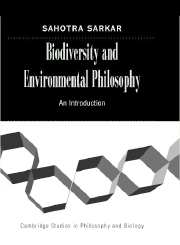Book contents
- Frontmatter
- Contents
- Preface
- Acknowledgments
- Biodiversity and Environmental Philosophy
- 1 Introduction
- 2 Concern for the Environment
- 3 Intrinsic Values and Biocentrism
- 4 Tempered Anthropocentrism
- 5 Problems of Ecology
- 6 The Consensus View of Conservation Biology
- 7 Incommensurability and Uncertainty
- 8 In Conclusion: Issues for the Future
- References
- Index
3 - Intrinsic Values and Biocentrism
Published online by Cambridge University Press: 17 July 2009
- Frontmatter
- Contents
- Preface
- Acknowledgments
- Biodiversity and Environmental Philosophy
- 1 Introduction
- 2 Concern for the Environment
- 3 Intrinsic Values and Biocentrism
- 4 Tempered Anthropocentrism
- 5 Problems of Ecology
- 6 The Consensus View of Conservation Biology
- 7 Incommensurability and Uncertainty
- 8 In Conclusion: Issues for the Future
- References
- Index
Summary
Why conserve biodiversity? This normative question has traditionally been part of the core of environmental ethics. In most of the discussions in the earlier chapters of this book – though not in Chapter 2, § 2.1 – we have simply assumed that we should attempt to conserve biodiversity. We attribute value to biodiversity, preferring its presence to its absence. But what is the source of this value? Why should we conserve biodiversity? We must be able to answer these questions if we are to have any confidence that we do not attribute value to biodiversity merely out of tradition, prejudice, or (what is much more plausible) fashion: biodiversity conservation is at present very fashionable in rich Northern societies. Moreover, answering these questions explicitly and convincingly is important above and beyond our having rational justification for attributing value to biodiversity. It has practical consequences, because arguments for biodiversity conservation must be made and evaluated in the political arena where decisions about the future of our biological heritage are made.
In that political arena, not everyone attributes value to biodiversity, or at least not to the same extent that biodiversity conservationists do. Among those who do not attribute value to biodiversity to the same extent that conservationists do are the owners and shareholders of the Japanese timber companies that have devastated Southeast Asian rainforests and are now moving to the neotropics; the ranchers who are trying to convert Amazonia into pasture; the loggers in the U.S. Pacific Northwest; and, perhaps most importantly, the owners and shareholders of the multinational oil companies that are now prospecting in many places around the world, including the Alaskan tundra and neotropical rainforests (for instance, in the western Amazon).
- Type
- Chapter
- Information
- Biodiversity and Environmental PhilosophyAn Introduction, pp. 45 - 74Publisher: Cambridge University PressPrint publication year: 2005



